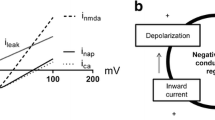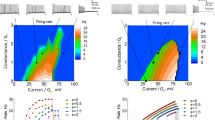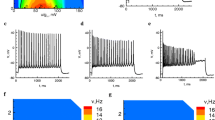Abstract
This work considers the response to simulated synaptic inputs of an excitable membrane model. The model is essentially of the Hodgkin-Huxley type, but contains an A-current in addition to sodium and delayed-rectifier potassium channels. The results were compared with previous simulations in which the stimulus was an injected current. These two types of stimuli give somewhat different results because synaptic stimuli directly change the membrane resistance, whereas injected current does not. The results of synaptic stimulation were similar to injected current in that very low frequencies of action potentials were elicited only where the stimulus was slightly above threshold. For most of the range of synaptic inputs that produced oscillatory behavior, the A-current had little effect on oscillation frequency. With synaptic stimuli as with injected current, the model membrane's spiking behavior does not begin immediately when an excitatory stimulus is imposed on a quiescent state. The delay before spiking is closely related to the inactivation time of the A-current. The synaptic results were different from the injected current results in that when substantial inhibition was present, the ability to produce very-low-frequency spiking was absent, even just above the excitatory threshold. The higher the degree of inhibition, the narrower the range of spike frequencies that could be elicited by excitation. At very high inhibition, no degree of excitation could elicit spiking.
Similar content being viewed by others
References
Alberts B, Bray D, Lewis J, Raff M, Roberts K, Watson JD (1989) Molecular biology of the cell (2nd edn) Garland Publishing, New York
Belluzzi O, Sacchi O, Wanke E (1985) A fast transient outward current in the rat sympathetic neurone studied under voltage-clamp conditions. J Physiol (Lond) 358:91–108
Bernander O, Koch C (1991) Synaptic background activity influences spatiotemporal integration in single pyramidal cells. Biol Bull 181:317–318
Byrne JH (1980) Quantitative aspects of ionic conductance mechanisms contributing to firing pattern of motor cells mediating inking behavior in Aplysia californica. J Neurophysiol 43:651–668
Connor JA (1978) Slow repetitive activity from fast conductance changes in neurons. Fed Proc 37:2139–2145
Connor JA, Stevens CF (1971) Prediction of repetitive firing behaviour from voltage clamp data on an isolated neurone soma. J Physiol (Lond) 213:31–53
Connor JA, Walter D, McKown R (1977) Neural repetitive firing: modifications of the Hodgkin-Huxley axon suggested by experimental results from crustacean axons. Biophys J 18:81–102
Davenport R, Jakobsson E, Gerber B (1991) Possible dual effect of synapses that are putatively purely excitatory or purely inhibitory: bases in stability theory and implications for neural network behavior. Biol Cybern 65:47–53
Doedel EJ (1984) The computer-aided bifurcation analysis of predatorprey models. J Math Biol 20:1–14
Doedel EJ, Jepson AD, Keller HB (1984) Numerical methods for Hopf bifurcation and continuation of periodic solution paths. In: Glowinski R, Lions JL (eds) Computing methods in applied sciences and engineering (vol 6). North-Holland, Amsterdam, pp 127–136
Gean P, Shinnick-Gallagher P (1989) The transient potassium current, the A-current, is involved in spike frequency adaptation in rat amygdala neurons. Brain Res 480:160–169
Glass L, Mackey MC (1988) From clocks to chaos; the rhythms of life. Princeton University Press, Princeton, NJ
Hassard B (1978) Bifurcation of periodic solutions of the Hodgkin-Huxley model for the squid giant axon. J Theor Biol 71:401–420
Hille B (1992) Ionic channels of excitable membranes. Sinauer, Sunderland, Mass
Hines M (1989) A program for simulation of nerve equations with branching geometries. Int J Biomed Comput 24:55–68
Hodgkin AL, Huxley AF (1952) A quantitative description of membrane current and its application to conduction and excitation in nerve. J Physiol (Lond) 117:500–544
Jakobsson E (1978) A fully coupled transient excited state model for the sodium channel. J Math Biol 6:235–248
Koch C, Poggio T (1987) Biophysics of computation: neurons, synapses, and membranes. In: Edelman GM, Gall WE, Cowan WM (eds) Synaptic function. Wiley, New York, pp 637–697
Koch C, Poggio T, Torre V (1986) Computations in the vertebrate retina: gain enhancement, differentiation and motion discrimination. Trends Neurosci 9:204–211
Premack BA, Thompson S, Coombs-Hahn J (1989) Clustered distribution and variability in kinetics of transient K channels in molluscan neuron cell bodies. J Neurosci 9:4089–4099
Rinzel J (1978) On repetitive activity in nerve. Fed Proc 37:2793–2802
Rogawski MA (1985) The A-current: how ubiquitous a feature of excitable cells is it? Trends Neurosci 8:214–219
Rudy B (1988) Diversity and ubiquity of K channels. Neuroscience 25:729–749
Ruppersberg JP, Stocker M, Pongs O, Heinemann SH, Frank R, Koenen M (1991) Regulation of fast inactivation of cloned mammalian I K (A) channels by cysteine oxidation. Nature 352:711–714
Salkoff L, Wyman R (1980) Facilitation of membrane electrical excitability in Drosophila. Proc Natl Acad Sci USA 77:6216–6220
Segal M, Rogawski MA, Barker JL (1984) A transient potassium conductance regulates the excitability of cultured hippocampal and spinal neurons. J Neurosci 4:604–609
Storm JF (1988) Temporal integration by a slowly inactivating K + current in hippocampal neurons. Nature 336:379–381
Author information
Authors and Affiliations
Rights and permissions
About this article
Cite this article
Gerber, B., Jakobsson, E. Functional significance of the A-current. Biol. Cybern. 70, 109–114 (1993). https://doi.org/10.1007/BF00200824
Received:
Accepted:
Issue Date:
DOI: https://doi.org/10.1007/BF00200824




